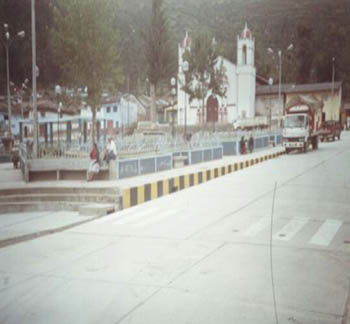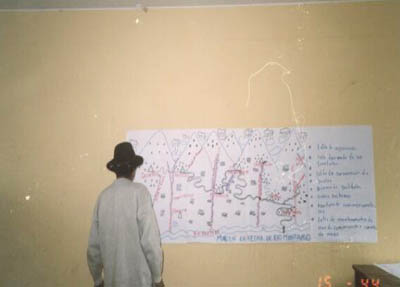How to Prepare an Emergency Preparedness Plan
Contents
Emergency Preparedness Plans - Technical Brief
Short Description
- Problem:
- Idea:
- Difficulty:
- Price Range:
- Material Needeed:
- Geographic Area:
- Competencies:
- How Many people?
- How Long does it take?
Introduction
This document addresses the emergency preparedness plans that resulted from the experience carried out in the emergency preparedness project in Peru. The methodology will have to be revised according to other more comprehensive risk reduction experiences and strategies that are implemented institutionally but that lack instruments such as the one described here.
Conceptual aspect
The Plan is an instrument to prevent or reduce disaster-related risks and decide how to act when an emergency takes place, by means of the participation of the vulnerable population in problem identification and decision making.
Disaster-related risks have two key factors: the threat or possibility of the occurrence of potentially destructive phenomena, and the vulnerability in the presence of threats; and the capacities of individuals and institutions to reduce risks and respond to emergencies.
The Plan ensures the identification of the main problems of disaster-related risks, the causes that generate them, and how to act in their presence.
Steps for the preparation of emergency plans

Preparing a PLAN is only possible if it relies on the participation and the coordinated efforts of all community
1. Identification and location of threats
We must be aware of the threats to which our community is exposed.
We have to determine which of these may cause emergency situations in the community. It is therefore necessary to know:
• The characteristics of potentially destructive phenomena and the areas that could be affected.
• The causes, possible consequences, and ways to prevent or diminish threats. To do this, it is important to share experience and receive technical advice from different institutions that provide services in our community.
• The history of the occurrence of destructive phenomena, their frequency, and the measures that were taken on these occasions
Emergency Preparedness Plans
2. Identification of vulnerable areas
Who are the people and what are the objects exposed to disaster threats.
• We have to identify the houses, buildings, farm land, roads, bridges, and transport means in areas of greater danger.
• We must be aware of the location and condition of access roads to the community, as well as alternative access routes.
• We must know the location of the population exposed to danger and also which individuals have some kind of mobility limitation or require specialised medical treatment.
3. Identification of internal skills and limitations
What is the community’s capacity to cope with or eliminate an emergency situation
To produce an inventory of human and material resources, their condition, location, and availability.
• Communities and families: survival mechanisms and response capacities in the work area. Communities and families: survival mechanisms and response capacities in the work area.
• Physical spaces and safe locations that could be used as gathering places or temporary shelters in cases of emergency.
• Means of transportation (public and private) that may be used in cases of emergency.
• Basic medical and first aid equipment.
• Protection and rescue equipment, such as: shovels, picks, ladders, ropes, etc.
• Electrical power systems and other possible supply sources.
• Water systems (aqueducts, wells, springs, and other possible supply sources.
• Contact addresses, telephone numbers, and employees of institutions that provide services in cases of emergency. Organisations. A directory of organisation and community leaders must be on hand.
Emergency Preparedness Plans
An inventory of resources allows us to know what the community has on hand to respond to an emergency situation. We may also measure the existing degree of organisation, and find out about the education and information requirements for the community to define concrete actions.
4. External Analysis (Opportunities and limitations)
• Government: structures, procedures, response mechanisms, and capacities (at national, regional, and local levels).
• Possible agencies with which to cooperate in cases of disaster, funds providers: structure, procedures, response mechanisms and capacities.
• Geographic coverage of the national and international organisations that work on the issue of disasters.
5. Preparation of the ACTION PLAN
For the preparation of the Action Plan, the following items must be included:
• WHAT? The tasks or activities to be carried out.
• WHAT FOR? The purpose or reason for carrying out the activity.
• HOW? The form that will take the activity.
• WHERE? The place where the activity is to be carried out.
• WHO? The individuals in charge of the activities to be carried out.
• WHEN? The time when the activity is to be carried out.
• WHAT WITH? The skills and resources on hand.
Emergency Preparedness Plans
|
Activity |
Purpose |
Form |
Place |
Individuals in charge |
Time |
Skills Resources |
|
|
|
|
|
Pedro Ana Luis |
|
|
For more information
Disaster Prevention and Local Governability Programme
Av. Jorge Chavez 275 - Miraflores. Lima - Perú
Tel: +51 (01) 447-5127 / 4467324/ 2429714
Website: http://www.practicalaction.org.pe
References and further reading
This Howtopedia entry was derived from the Practical Action Technical Brief Energy from the Wind.
To look at the original document follow this link: http://www.practicalaction.org/?id=technical
Usefull addresses
Practical Action
The Schumacher Centre for Technology & Development, Bourton on Dunsmore, RUGBY, CV23 9QZ, United Kingdom.
Tel.: +44 (0) 1926 634400, Fax: +44 (0) 1926 634401
e-mail:practicalaction@practicalaction.org.uk web:www.practicalaction.org






